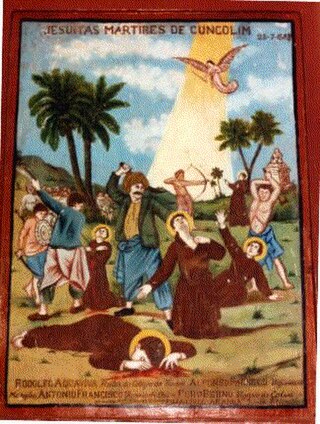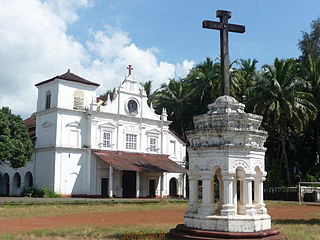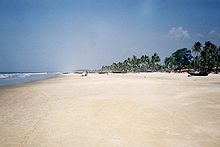
Ponda (Portuguese: Pondá, is a city and a municipal council in the South Goa district of Goa, India. Located in the central area of Goa, Ponda lies 28 km southeast of Panaji, the capital of Goa and 17 km northeast of Margao, the district headquarters. Ponda is also known as "Antruz Mahal" because of the presence of numerous famous temples and rich cultural heritage.

Margao is the commercial capital of the Indian state of Goa. It stands on banks of the Sal river and is the administrative headquarters of Salcete sub-district and South Goa district. It is Goa's second largest city by population after Vasco.

Salcete is a subdivision of the district of South Goa, in the state of Goa, situated by the west coast of India. The Sal River and its backwaters dominate the landscape of Salcete. Historically, the sixty-six settlements south of the Zuari River formed the original Salcette territory. Salcete forms a part of the bigger Konkan region that stretches along the western shoreline of peninsular India.
Dom Diogo Rodrigues, Dom Diogo Roiz was a Portuguese explorer of the Indian Ocean who sailed as an ordinary helmsman under the command of Dom Pedro Mascarenhas around Goa. They sailed from the Cape of Good Hope eastward into little-known waters of the newly discovered route to Goa. Rodrigues island was named after him between 4 and 9 February 1528 because he had discovered it during his only return journey from Goa via Cochin to Lisbon, where he was elevated to the rank of a knight (cavaleiro) by John III of Portugal. He then returned to Goa and made a mark in the history of the Portuguese empire in the subcontinent around the mid-16th century.

Navelim is a census town and fast growing suburb of the city of Margao located in the Salcete sub-district of South Goa district, Goa, India. It has a large parish and has played a crucial rule in South Goa politics at some stage. The region falls in the coastal South Goa sub-district of Salcete. It has been connected with some important persons from the world of Goan history too.

Benaulim (Bannalem) is a village in the state of Goa, India. Located in Salcete taluka of South Goa district, it neighbours Colva village to the north, Margao in the northeast and Varca village to the south. During Portuguese rule, it was one of the nine communidades in Salcete. Benaulim is the birthplace of St Joseph Vaz, who was a priest and missionary in Sri Lanka. Benaulim is home to several traditional carpenters, and has long been known as Goa's 'village of carpenters'. Contemporary Benaulim is a popular seaside resort, renowned for its beautiful rice fields, balmy weather and golden sand beaches. It also houses Goa's only Don Bosco Animation Centre. There are two big churches in Benaulim. The Holy Trinity Church in Mazilvaddo is a modern church built over the centuries-old chapel of the Loiola Pereira family. The St John the Baptist Church in Povacao area closer to Colva, is where St Joseph Vaz was baptised.
Cuncolim is a town in South Goa district in the state of Goa, India.

Chinchinim is a census town in Goa state, India. It is located in the Salcete taluka of South Goa district. Prior to achieving the current status of a small town, it was considered one of the biggest villages of southern Goa.

Hinduism is the majority religion of Indians living in Goa. According to the 2011 census, in a population of 1,458,545 people, 66.1% were Hindu.

Shri Shantadurga Saunsthan is a private temple complex belonging to the Goud Saraswat Brahman Samaj located 30 km (19 mi) from Panaji at the foothill of Kavalem village in Ponda Taluka, Goa, India.
Loutolim or LoutulimLottli pronounced:[lɔːʈlĩː], Portuguese: Loutulim) is a large village of South Goa district in the state of Goa, India. It is an important settlement in the Salcete sub-district.

Cortalim is a village in Morumugão, Goa, India. Its native Goan population is entirely Catholic and their main occupations include fishing and agriculture. Located on the banks of the Zuari River, it was previously known as Kushasthale.

The Cuncolim Massacre or Cuncolim Revolt was an incident that involved the massacre and mutilation of Christian priests and civilians by Hindu chieftains in the Portuguese Goa village of Cuncolim on Monday, 15 July 1583.
Mahamaya Kalika Saunsthan is a temple complex in Kansarpal village of Bicholim taluka in the state of Goa, India. The presiding deity of the temple is Kali worshipped in the form of Mahamaya. The goddess Kali, the terrible and cruel to the demons and evil doers, is worshiped with blood sacrifice in most parts of India, in Goa however the fierce invocation of the deity was never popular. As per the tradition, after slaying the demons Madhu and Kaitabha, the deity's anger was soothed and the deity manifested herself in a peaceful (Shanta), gentle (Soumya) form, which is very popular in Goa.This form of Kali is also known as Bhadrakali or Kali who is gracious.
Quelossim is a village in Mormugao taluka, South Goa, India. This village was known as Kardalipura in ancient times and had a beautiful temple dedicated to the Mother-Goddess Shri Shantadurga and Shri Kavale Math which was shifted to Kavale 450 years ago when the Portuguese demolished the shrine as a part of the inquisition. The original temple was built by a Goud Saraswat Brahman trader Anu Shenvi Mone, but was destroyed during the religious persecution period around 1566 AD. Today the exact location can be accessed from NH66 via Kesarval Spring en route to Rassaim or Loutolim, where one can see a few architectural ruins, in the form of the original temple lake. A small modern day shrine is seen under a huge banyan tree, at the end of this route property owned and maintained by Shree Shantadurga Saunsthan, Kavale and this area is protected by the Directorate of Archives and Archaeology, Government of Goa.

Kavale or Kavalem is a village in Ponda, Goa, India. Kavle/Kawale/Kawle are other variations for the same name.

The Christian population of Goa is almost entirely Goan Catholics, whose ancestors converted to Christianity during Portuguese rule. Christianisation followed the Portuguese conquest of Goa in 1510, which was followed by the Goa Inquisition from 1560 onwards. The Hindu population is mostly descended from immigrants from other states of India, who have been arriving in Goa since the last century There is a higher proportion of Christians in Velhas Conquistas than in Novas Conquistas.

The Igreja de Nossa Senhora das Neves is a historical Catholic church in Rachol village, Salcete sub-district, on the southern banks of the Zuari river, in the South Goa district of Goa state, India. The church was built in the 1560's during the Goa Inquisition. It is situated in close proximity to the renowned Rachol Seminary. There is a church of the same name in the neighbouring village of Raia.

Shri Damodar Temple Zambaulim or Shri Damodara Sansthaan is a Hindu temple on the bank of the Kushawati River near the village of Zambaulim 22 km from the city of Margao on the border of Quepem region in the south of Goa. The temple houses a celebrated murti, or image, of Lord Shiva incarnated as Lord Damodar.

















